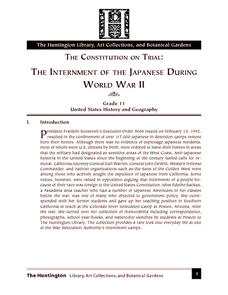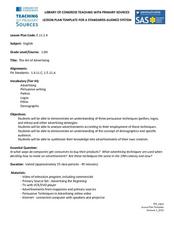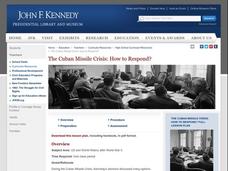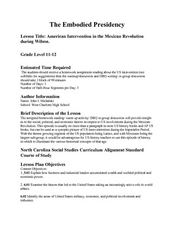Curated OER
Natural Disasters: Nature's Fury
Students explore the human experience. In this business ethics lesson plan, students analyze primary sources to develop an understanding of the American natural disasters of the 19th and 20th centuries and the implications they presented.
Curated OER
Working Conditions in the Industrial Age
Students examine working conditions during the Industrial boom. In this Industrialization lesson, students analyze primary sources in order to chart the responsibilities of workers in industrial jobs.
Curated OER
The Constitution on Trial: The Internment of the Japanese During World War II
Eleventh graders analyze primary source documents during the Second World War. Students recall statements of Japanese-Americans who were placed into internment camps during the war.
Curated OER
Slavery and the Legal Status of Free Blacks
High schoolers examine the status of free blacks in Illinois and slavery in the U.S. They read and analyze primary source documents, answer and discuss questions, participate in a group discussion, and present the group's findings to the...
Curated OER
Lesson Plan for History: The Inauguration Speech of President Jefferson Davis
Eleventh graders explain Davis's views on Southern Secession. In this American History instructional activity, 11th graders read and analyze primary sources.
Curated OER
Segregation: From Jim Crow to Linda Brown
Young scholars examine the African American social, economic, and political conditions between 1896 and 1953. In this segregation lesson, students analyze primary sources to develop an understanding of the plight of African Americans'...
Curated OER
New Deal Programs: Brother, Can You Spare a Dime?
Students research New Deal programs. In this Great Depression lesson, students analyze primary sources to develop an understanding of the effects of the depression and how WPA programs and other New Deal programs impacted people's...
Curated OER
How Connecticut Benefited from American Slavery
Eleventh graders explore Connecticut slavery. In this American slavery instructional activity, 11th graders analyze primary sources relating to slavery in the state as they research in collaborative groups. Students determine whether...
Curated OER
The Art of Advertising
Get your class thinking about advertising with this lesson plan. Over the course of 15 days, your class will discuss advertising techniques, study the concepts of pathos, logos, and ethos, and analyze the persuasive techniques of...
Roy Rosenzweig Center for History and New Media
American Indians and their Environment
People could take a page in ingenuity and survival from the Powhatans. Deer skins became clothes, and the members of the Native American group farmed the rich Virginia soil and hunted in its forests for food. Using images of artifacts...
Tennessee State Museum
Understanding Women’s Suffrage: Tennessee’s Perfect 36
Tennessee was the pivotal state in ratifying women's suffrage in 1920, with its vote coming down to one man: Harry Burn, a 24-year old state representative who changed his nay to an aye on the advice of his mother. Learn more about...
John F. Kennedy Presidential Library & Museum
The Cuban Missile Crisis: How to Respond?
For 13 days, the United States stood on the edge of nuclear War. The Soviet Arms buildup in Cuba is the focus of an activity that asks groups to analyze how the governmental role each of John F. Kennedy's advisors played went on to...
University of California
The Civil War: Effects of the Civil War
Imagine being on the front line of the Civil War —from the front porch of your own house. Scholars use visual evidence from primary and secondary sources to analyze the impact of the Civil War on all Americans. They examine the research...
Facing History and Ourselves
The Nazis in Power: Propaganda and Conformity
The Nazis used the power of propaganda to encourage confirmative views and the discrimination of Jews. A social studies resource illustrates these issues through discussion, image analysis, and a writing exercise.
Alabama Department of Archives and History
Alabama's 1901 Constitution
"We, the People of the State of Alabama. . ." Did you know that the Alabama State Constitution has 357,157 words while the US Constitution has only 4,400? And that it has 798 amendments while the US Constitution has 27? Class groups...
Curated OER
Critically Examining, Analyzing and Evaluating Picture Books on Aboriginal Canada
Students combat pervasive stereotypes. In this Critical Analysis lesson plan, students examine and evaluate the stereotypes of Aboriginal groups, as depicted in a picture book. Students will use primary and secondary sources to compose...
Curated OER
Sam Houston for President...Again
Fourth graders discover the political career of Sam Houston. In this Texas history instructional activity, 4th graders research primary resources and create a modern-day version of Sam Houston's political campaign of the 1840s.
Curated OER
Beyond Demographics
Students study the culture of the Dominican Republic. In this Peace Corps lesson, students watch, "Destination: Dominican Republic." Students also examine primary source materials on the nation and discuss their findings.
Curated OER
The Embodied Presidency Wilson
Young scholars take a closer look at U.S. intervention in Mexico. In this 20th century history lesson, students examine primary documents to consider why the United States entered the Mexican War and then write DBQ essays on the topic.
Curated OER
Cabeza de Vaca Meets the Coahuiltecans
Students examine the difference between primary and secondary sources by examining the journal of Cabeza de Vaca and creating a poster about the Coahuitecan Indian groups. They portray a scene of the groups in 16th Century south Texas.
Curated OER
The United Nations and Women
Students analyze the role of the Commission on the Status of Women in the post-WW II era by looking at the general framework the Committee worked within. They propose their own solutions to the case studies.
Curated OER
South Korea
Students use primary and secondary resources in order to investigate the culture of South Korea. They use guiding questions that progressively lead them to higher order thinking to make connections from the information to how people live.
Curated OER
All Men Are Created Equal
Students engage in a lesson plan to investigate the concept of all men being equal. The concept has a historical context during the time of the American Revolution. They use primary and secondary sources in order to discover the concept...
Curated OER
Magic Eye
Students discuss the history of tobacco bag stringing. In this primary documents history lesson, students closely examine photographs of families who worked stringing tobacco bags. This lesson includes discussion questions and a...

























